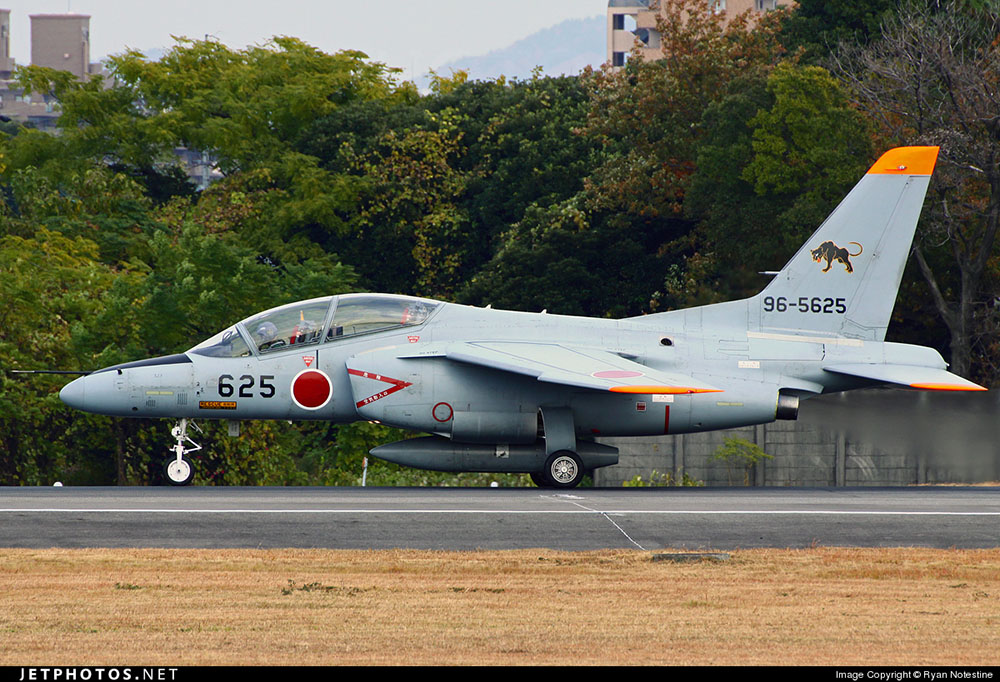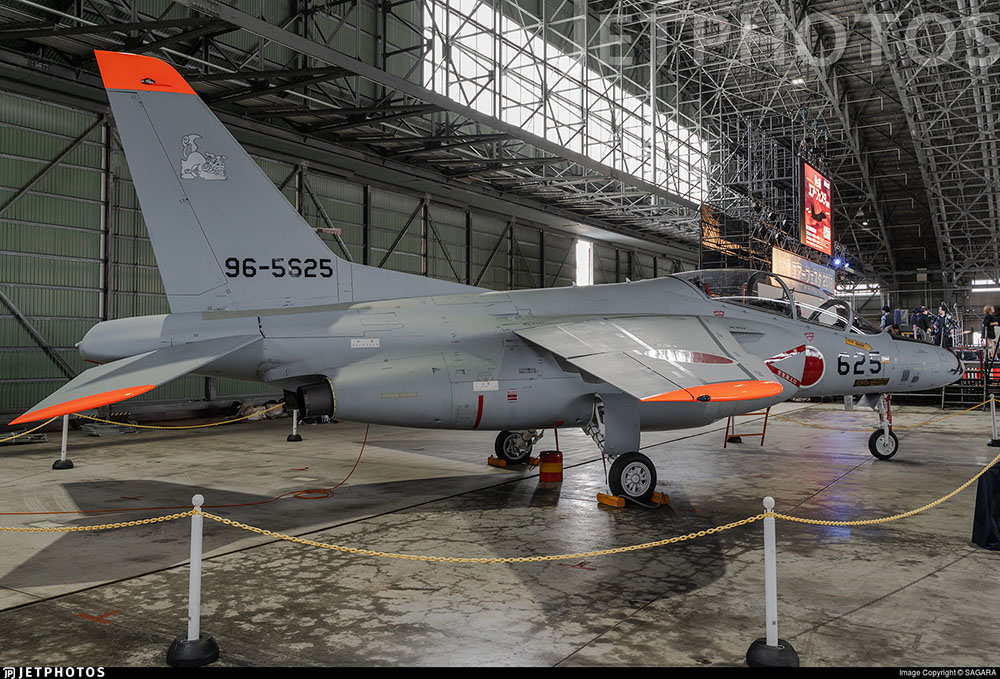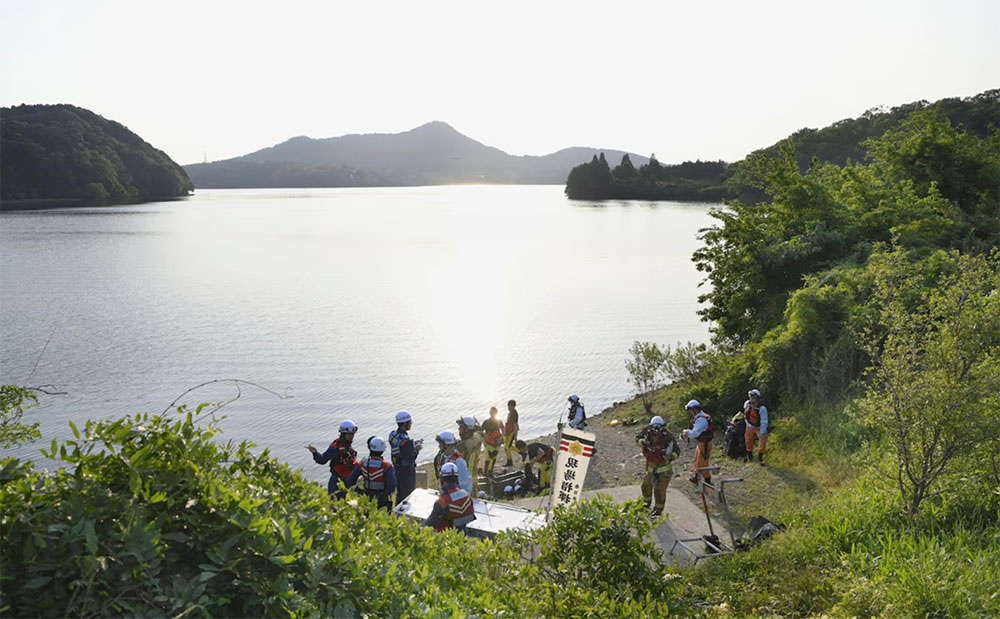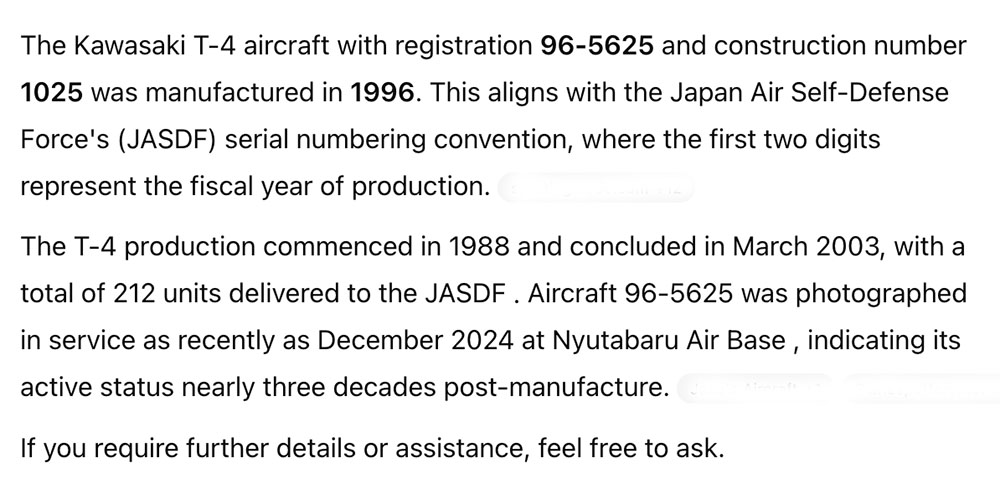ASX Latest Accident
Fatal Accident (2) - Japan Air Self-Defense Force - JASDF, Kawasaki T-4, 96-5625, Inuyama City, Aichi Prefecture, Japan, May 14, 2025.
Interactive Map
Accident Information
| Approx. Accident Location | Aircraft Fat. | Aircraft Inj. | Ground Fat. | Ground Inj. | ASN Entry |
|---|---|---|---|---|---|
| 35°20'42.90"N, 136°59'29.80"E | 2* | 0 | 0 | 0 | Aviation Safety Network |
Aircraft Information
| Type | Operator | Registration | Serial Number | Manufacture Date |
|---|---|---|---|---|
| Kawasaki T-4 | JASDF | 96-5625 | 1025 | 1996* see image |
 |
 |
 |
 |
 |
 |
Videos
|
2018 video of accident aircraft
|
|
|
Skye on Aviation Safety X
|
ASX Accident Report
On May 14, 2025, at approximately 15:00 local time, a Japan Air Self-Defense Force Kawasaki T-4 training aircraft, tail number 96-5625 and assigned to Nyutabaru Air Base, crashed into Iruka Pond in Inuyama City, Aichi Prefecture. The aircraft had departed from Komaki Air Base shortly before the incident. According to defense officials, the T-4 disappeared from radar two minutes after takeoff. The flight was a return leg after a maintenance ferry mission involving an F-15 fighter jet. The two crewmembers onboard were a highly experienced captain who had piloted the F-15 earlier that day and a first lieutenant assigned to the T-4.
Witnesses near Iruka Pond reported hearing a loud noise followed by emergency vehicle sirens, with some reporting visual confirmation of the aircraft entering the water. Emergency services were dispatched quickly, and fragments of the aircraft were soon recovered from the pond’s northwest section. Additionally, lifesaving equipment, helmets, and uniform items believed to belong to the crewmembers were found floating on the surface. Divers and search teams continued operations into the evening, although the aircraft itself was presumed to have sunk.
Weather conditions at the time of the crash were not reported as severe, and no adverse meteorological factors have yet been identified. The T-4 aircraft involved was a 36-year-old platform with no flight data recorder or cockpit voice recorder installed, which presents complications for accident investigators. While the Japan Ministry of Defense has not yet confirmed the cause, they have acknowledged the absence of mechanical distress calls or warning indicators from the crew before radar contact was lost.
In response to the crash, the Japan Air Self-Defense Force grounded nearly 200 Kawasaki T-4 aircraft nationwide pending a thorough review of maintenance records and flight safety protocols. The aircraft, introduced in the late 1980s, has served extensively as a jet trainer for JASDF pilot development programs. The Ministry of Defense emphasized the need for cautious and comprehensive checks before resuming flight operations to ensure no systemic failure contributed to the incident.
The search continues for the missing crewmembers, although the discovery of helmet fragments and other personal gear increases concern about survivability. Investigations remain underway, involving the Self-Defense Forces, local law enforcement, and aviation safety officials. Recovery operations are focused on extracting the submerged fuselage and collecting environmental samples due to observed fuel leakage in the water.
This page will be updated as more information becomes available.
Flight Tracking
Upon reviewing the available data from Flightradar24, FlightAware, ADS-B Exchange, and AirNav Radar, there is no publicly accessible flight tracking information for the Japan Air Self-Defense Force (JASDF) Kawasaki T-4 aircraft, tail number 96-5625, involved in the May 14, 2025, crash near Iruka Pond in Inuyama City, Aichi Prefecture. This absence is consistent with the operational characteristics of military aircraft, which often do not broadcast ADS-B signals or have their transponder data publicly available due to security protocols.
The lack of flight data is further compounded by the aircraft's equipment; the T-4 in question was not fitted with a flight data recorder or cockpit voice recorder. This omission presents significant challenges for investigators attempting to reconstruct the flight path and determine the sequence of events leading to the crash. As a result, the investigation relies heavily on physical evidence recovered from the crash site, eyewitness accounts, and maintenance records.
The Japan Ministry of Defense has confirmed the recovery of various aircraft fragments, including parts of the fuselage and pilot equipment, from Iruka Pond. Additionally, fuel leakage has been observed in the water, prompting environmental concerns and necessitating containment measures. The search for the missing crew members continues, with efforts focused on underwater recovery operations and analysis of the recovered debris.
In response to the incident, the JASDF has grounded nearly 200 T-4 aircraft nationwide to conduct thorough safety inspections and review operational protocols. This precautionary measure aims to ensure the airworthiness of the fleet and prevent similar occurrences in the future. The T-4, introduced in 1988, has been a staple in JASDF pilot training programs, and this incident marks a significant moment in its operational history.
The investigation remains ongoing, with multiple agencies collaborating to ascertain the cause of the crash. Given the absence of flight data and the challenges associated with underwater recovery, the process is expected to be meticulous and time-consuming. Findings from this investigation will be crucial in informing future training and maintenance practices within the JASDF.
Tracking and Social Media
- Flight Tracking: Flightradar24, FlightAware, ADS-B Exchange, AirNav Radar
- Social Media: Facebook, Instagram, X (formerly Twitter), YouTube
Sources and References
🚨 Subscribe, Donate... or both!
It’s totally secure — we never even see your number.
test1
